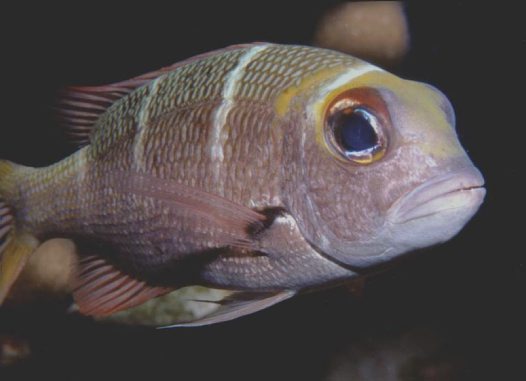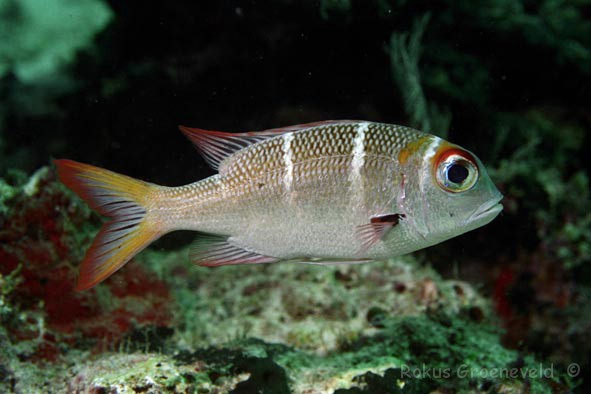
Monotaxis grandoculis
FAMILY
Lethrinidae
TAXONOMY
Monotaxis grandoculis (Forsskеl, 1775), Jidda, Saudi Arabia, Red
Sea.
OTHER COMMON NAMES
English: Big-eye barenose, big-eye bream; French: Emperor
bossu; Japanese: Yokushima-kurodai.
PHYSICAL CHARACTERISTICS
The body is oblong with a strongly convex profile of the head
anterior to the eye; the snout is steeply sloped. The mouth is
relatively large with pronounced canines and molars that are
used for grasping and crushing prey, respectively. The eye is
large; juveniles have a prominent black stripe through the eye.
The dorsal fin has 10 slender spines and 10 soft rays, the anal
fin has 3 spines and 9 soft rays, and the pectoral fin has 14
rays. The caudal fin is forked in adults and somewhat lunate in
juveniles. Body color is light brown to bluish grey; ventral surfaces
are white. Three prominent black or dark brown saddles
cover the flank dorsally. Fins and the caudal peduncle range
from yellow or reddish orange to clear or dusky. The lobes of
the caudal fin may be pink in adults. Able to switch between
dark and light color forms by
BEHAVIOR
al control, usually in response
to the color of the sea bottom. Grows to 23.6 in (60
cm) in total length.
DISTRIBUTION
Indo-West Pacific, from the Red Sea and East Africa east to
the Hawaiian Islands, southeast to French Polynesia, south to
northern Australia, and north to southern Japan.
HABITAT
Tropical coral and rocky reefs, over coral, sand, and rubble.
FEEDING ECOLOGY AND DIET
Feeds at night upon gastropods, echinoderms (mainly sea stars
and brittle stars, but also sea cucumbers), crabs, polychaete
worms, and tunicates.
BEHAVIOR
Often solitary in the water-column; juveniles closer to the bottom.
Adults also form large aggregations that swim lazily over
the reef or reef slope.
REPRODUCTIVE BIOLOGY
Little is known. Probably forms spawning aggregations and
produces pelagic eggs and larvae.
CONSERVATION STATUS
Not listed by the IUCN.
SIGNIFICANCE TO HUMANS
Taken in commercial, subsistence, and recreational fisheries;
juveniles are collected infrequently for the aquarium trade, and
adults are collected for large public aquaria. May be ciguatoxic
in some areas, such as the Marshall Islands.
Photo Gallery of - Humpnose big-eye bream





 Animalia Life
Animalia Life